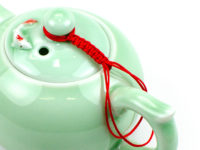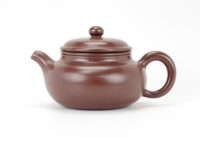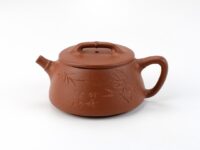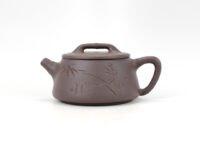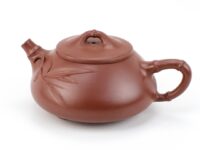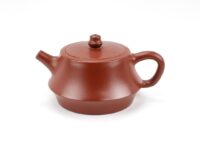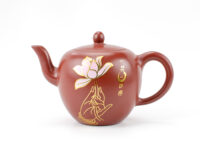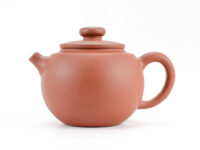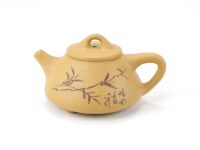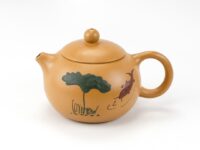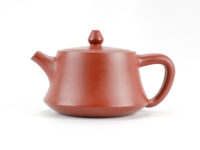A brief history of Yixing Teaware (Zisha Hu or “Purple Sand Pot”)
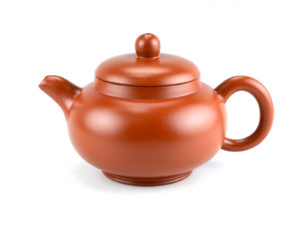
Yixing tea pots are also called zisha hu in Chinese, which translates to “purple sand pot.” Approximately five to six thousand years ago ceramic activity first emerged in the city of Yixing which is located in the southern Jiangsu Province. At that time, Yixing city was one of the famous production areas of ceramic pottery in the east, but in the Tang Dynasty potters started to teem with zisha ni or purple sand clay. By the early Ming Dynasty, the popularity of this specialized form of pottery increased, and replaced other ceramic ware to become the preferred tea accessory. Commonly, yixing tea pots are used for wulong, puer and black teas. In some cases green tea can be infused in a pot, but you have to be careful not to over brew the tea leaves since these pots maintain a very high temperature of water for a sustained period of time.
Zisha Hu, or Purple Sand Tea Pot, is a unique Chinese art form that developed during the Song dynasty (960-1279), but reached the height of its fame during the early Ming Dynasty (960-1644) through the Qing Dynasty (1644-1911). This very elegant, but simple style of earthenware became increasingly popular as tea preparation itself moved towards simplicity. The process of preparing tea during the earlier Tang Dynasty (618-907) involved grinding of leaves and the addition of incense. As this complex method began to fall out of favor it was replaced with the use of simple, but wonderful whole tea leaves and buds. The unglazed and uncolored purple sand clay teapot proved it could best capture the real color and fragrance of this new style of tea. In addition, its aesthetics reflected the cultural and philosophical ideas of the times. Transcending its purpose of brewing tea, zisha tea ware became a symbol of simplistic beauty.
Sometime between the late Song Dynasty to early Ming Dynasty, zisha clay was identified as an ideal material for brewing tea. The reason for this is its distinctive mineral content. The clay is rich in iron, quartz, mica, kaolin, hematite, isinglass, in addition to many other trace minerals. The iron contained in the clay helps sustain the temperature of the heated water, allowing for a very rich and complex infusion of tea. The quartz and other components leave mineral remains after the clay is fired at 1100-1180 degrees Celsius. This creates a distinctive double pore surface. This highly porous structure is the key element that makes Yixing ware indispensable for fine tea drinking. These many microscopic holes not only allow the pot to adapt to drastic changes in temperature, but also allow the tea to breathe which in turn brings out the fragrance, color and taste of the original tea leaf. The tea’s delicate oils are absorbed into the walls of the pot, creating yet another enhancement of flavor. Therefore, brewing one type of tea will give a distinctive character to your zisha ware.
An explanation of how Yixing teaware is made
“I love purple clay for it has no color of glaze, just like that you can see one’s mind directly. One doesn’t rely on the appearance to show his nobility, and only that which is true in nature is most valuable and pleasing.”
Gao Zhuang
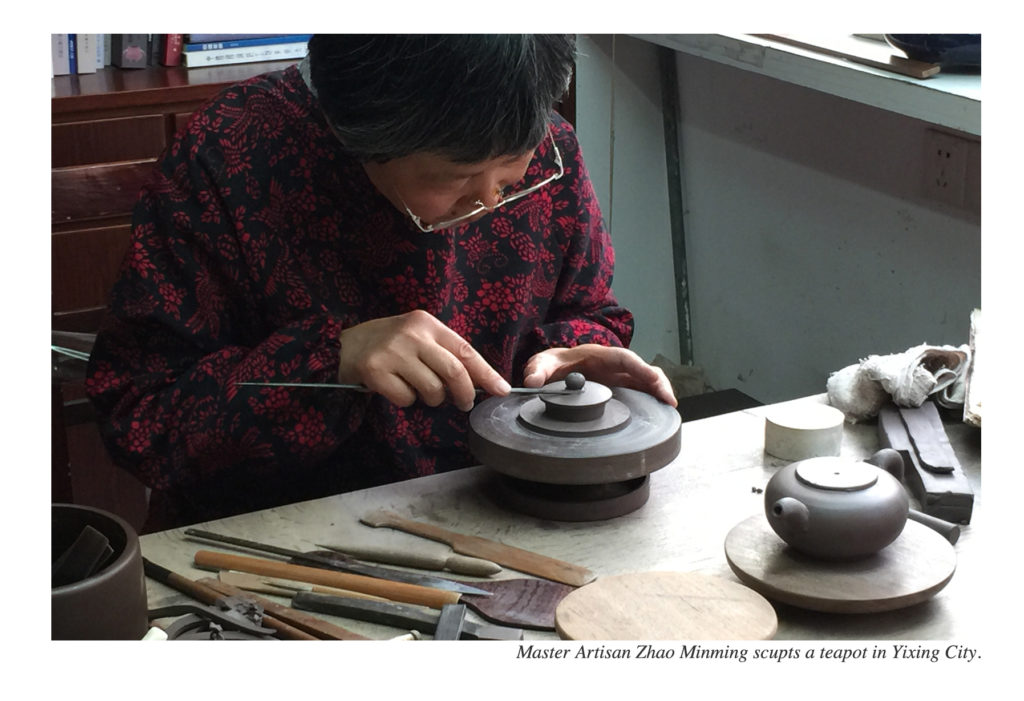
The making of zisha tea ware begins within the mountains of Yixing where 350 million year old mineral deposits rest. These minerals have formed a material the Chinese call “purple sand clay” or “zisha”. Once the unprocessed zisha, which resembles a piece of rock with a flaky outer surface, is mined and extracted the clay must be selected and worked by hand. Separated by color, the pieces are laid out and allowed to be weathered naturally by the sun, the wind, and the rain until the clay reaches approximately the size of a soybean. Higher quality clay is weathered for several years before being processed, but due to increased popularity and the faster pace of modern times this action is often sped up by machines that crush the clay into finer pieces. Once weathered, the clay is ground into a fine powder and magnets are held over the material in order to extract excess iron content. This will help create a finer, smoother end product. Finally, it is sifted many times and tempered by water creating the mature clay that will eventually be molded into various pieces of pottery.
The three kinds of Zisha clay
There are three kinds of zisha clay: purple clay, red clay, and green clay. Each material can be made into pottery on its own or mixed with the other two kinds of clay. In 1916, potters began to add oxidized metal to the fine clay powder in order to achieve a variety of colors like, dark purple, pear brown, copper, or dark green. However, the most cherished pots are still the natural untouched zisha clay. Purple clay is the most common type of Yi Xing tea ware and usually resembled a dark brown once fired. Green clay is only found in small quantities and therefore it is rare to see an entire pot made of this material. It is usually used for accents and decoration and resembles the color of a dark egg shell once fired. Red, or Zhuni pots, are not as common as the purple clay, but can still be found in larger amounts than the green clay. This material is located deep within the mountain layers towards the bottom of the mineral deposits making it more difficult to find and therefore more sought after.
Completing the construction of the Yixing teapot
Once ready to construct a piece of pottery the clay is re-hydrated and pounded to remove any excess air bubbles. High quality clay is pounded for weeks achieving a very even and consistent surface. The worked zisha clay possesses many unique qualities. It has a near perfect plasticity making it possible to create many different sizes and shapes coupled with sharp, distinct designs. Its cohesive force is also strong, but not sticky when worked with either hands or tools. This is an important factor since these pots are rolled and pressed, not thrown like some other forms of ceramic ware. Yixing tea ware is often made in various pieces such as the spout, lid, handle and base; which are created separately and later gently molded together. Also, the shrinking force is very small only reducing in size about ten percent from molding to firing. This allows for precise fitting and closely matched lids helping the teapot sustain the correct water temperature for a complete tea infusion. Lastly, there exists an appropriate quantity of ferric oxide and many other micro-metallic elements making the color of a zisha teapot plain and graceful. Since the simplistic beauty is much sought after, it is rare that a potter will enhance its natural form with glazes. If you’d like to see the construction of something similar in action, check out our video on Chaozhou and Zhuni teaware.
Selecting your Yixing teapot
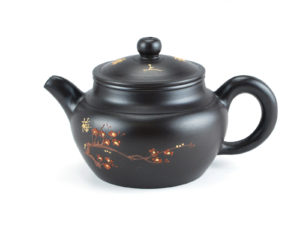
Zisha teapots are very popular among collectors, but although a respected art form these fine ceramic pieces are not just for decoration. The pot exists as a partner to the tea and should be used and enjoyed. In general there are five styles of zisha tea ware and through experience and time you will slowly begin to discover what pot best suits your personal style and needs.
- Round Tea Pot: This is generally considered a feminine design. The open structure is great for the use of tightly packed oolong teas like Monkey Picked because the space allows for the full opening of the leaves.
- Square Tea Pot: A masculine design that is extremely difficult to make. If not assembled correctly the firing process can easily distort the angles of a square pot ruining the overall design. The walls are generally thicker so these tea pots are good for strongly oxidized teas that require a higher water temperature to get a full flavored infusion.
- Ribbed Tea Pot: This is a very difficult design that is similar in shape to a round tea pot. It takes a very skilled craftsperson to create a ribbed tea pot that is perfectly matched between the body, lid, and spout.
- Nature and Mythology Motifs: To beginning tea drinkers these tea pots are very appealing because they require little knowledge of tea to be appreciated. Often depicting common animals and mythology, these pots are delightful to look at.
- Tea Ware Replications: It has become increasingly popular for zisha potters to recreate famous historical tea sets that had been constructed from various other materials. This type of tea set is used mostly for display.
How to prepare your new Zisha Yixing teapot
There are two ways to prepare a zisha tea pot for use. One requires boiling the entire pot in water, but unless you are experienced with this process it is easy to damage the delicate structure of your pot. We recommend the method described below because it is both safe and effective.
- Pour room temperature water inside your tea pot and let sit for 4-5 hours, or overnight.
- Pour the water out and choose the type of tea that you would like to enjoy in your new pot. Brew your selected tea with boiling water to start.
- Let the water cool to room temperature then pour out.
- Reuse your tea leaves for two more infusions allowing them to cool to room temperature before pouring them out. Do this twice more to open the pores of the clay and reduce the scent and flavor of the clay.

